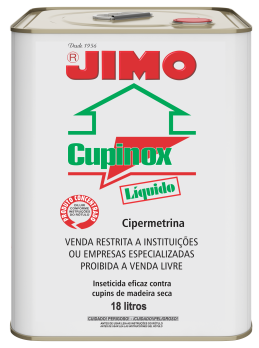JIMO CUPINOX LÍQUIDO

JIMO CUPINOX LÍQUIDO
-
 kills termites and borers
kills termites and borers -
 professional use
professional use -
 protects wood
protects wood -
 residual power
residual power
Insecticide with preventive and curative action, effective against dry wood termites, supplied in the form of a concentrate for dilution in solvent and application by brushing, spraying and immersion.
JIMO CUPINOX LÍQUIDO is a preventive and curative insecticide, effective against dry wood termites. It is supplied in the form of a concentrate for dilution in solvent and application by brushing, spraying and immersion.
INDICATIONS FOR USE: It is recommended for the treatment of wood destined to the civil construction and furniture industry, in the immunization of moldings of the internal plywood panels, as well as in the agglomerated wood that cover these panels and in the immunization of the filling wood, as in the external plywood surfaces . It is also indicated for the immunization of floors, parquets, ceilings, jambs, windows, doors, frames, fences, posts, posts, poles and sheds.
18 L can
YIELD
Brushing or spraying: The yield for treatment is 3 to 5 m² / liter for raw wood and 8 to 10 m² / liter for worked wood, such as furniture, floors, frames, etc., in spray or brushing treatments. The application of 1 full coat on all sides of the wood is indicated.
Immersion: It is the most suitable method when there is a need for greater retention of the product in the wood. It is necessary to have a tank sized according to the material to be treated and, in order to avoid losses of the immunizer, it is advisable to install a drainage channel to collect and reuse the excess product that drips from the treated wood. The duration of the bath depends on the porosity of the wood. In general, a few seconds or a few minutes of immersion are sufficient. The treatment of the least resistant parts can be done by repeated brushing or by immersing only the ends. Also in the immersion process, the yield is directly linked to the type of wood bathed. Consumption, however, varies within the limits of previous processes.













